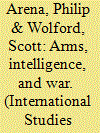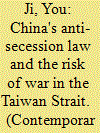| Srl | Item |
| 1 |
ID:
117525


|
|
|
|
|
| Publication |
2012.
|
| Summary/Abstract |
How do states respond to uncertainty over their opponents' military strength? We analyze a model of crisis bargaining in which, prior to negotiation, an uninformed state chooses how to allocate scarce resources across armaments and intelligence gathering. Arming improves military capabilities, while intelligence gathering improves estimates of the other state's military capabilities. Our model thus allows both the distribution of power and the level of uncertainty in the crisis to be determined endogenously. We derive some notable results. First, the relationship between information revelation and war is conditional on beliefs held before the information is received, as more accurate information can reduce the probability of war for optimistic states but increase it for pessimistic ones. Second, the allocations that minimize the probability of war are often not those made in equilibrium. Finally, considering the interdependence between the two allocations yields unique insights into the relationship between the distribution of capabilities, uncertainty, and the risk of war.
|
|
|
|
|
|
|
|
|
|
|
|
|
|
|
|
| 2 |
ID:
072887


|
|
|
|
|
| Publication |
2006.
|
| Summary/Abstract |
The product of a ten-year debate, China's Anti-Secession Law assures Taiwan and the world that peaceful independence is a myth. The law explains that China is building military superiority to prevent Taiwan's de jure independence. This threat is matched by peace inducements, mainly economic integration, to increase the cost of independence. The ASL channels hard and soft approaches into one legal framework. Yet to this author, the ASL is fundamentally not a piece of law but a statement of Hu Jintao's new thinking. It enriches China's Taiwan policy of maintaining peace through the threat of war, the final line of defence against de jure Taiwanese independence. This article explains how the status quo is used against independence and how deliberate ambiguity has enlarged Beijing's space of manoeuvring with both Taipei and Washington. Beijing does not want war, but it must insist on its likelihood. The absence of a reunification timetable in the ASL shows that Beijing is not in a hurry to resolve the Taiwan issue. Beijing also has encouraged Washington to play a more active role in coordinating the cross-Strait interaction. The likelihood of war can best be reduced by building ambiguity into the cross-Strait relationship to avoid pressure for drastic action.
|
|
|
|
|
|
|
|
|
|
|
|
|
|
|
|
| 3 |
ID:
155269


|
|
|
|
|
| Summary/Abstract |
Russian President Vladimir Putin believes that offense-dominant military practices hold significant advantages in contemporary interstate conflict. Either through non-linear means or through the use of advanced conventional weaponry, the Russian Federation has begun to act as if those who attack first and decisively have the upper hand in war. In such an environment, interstate war is more likely as misperception and misjudgment can more easily spark conflicts that both sides feel compelled to initiate.
|
|
|
|
|
|
|
|
|
|
|
|
|
|
|
|
| 4 |
ID:
147031


|
|
|
|
|
| Summary/Abstract |
Until recently the international environment reflected a relative calm among major powers as the numerous proxy wars of the Cold War period had largely gone silent. The number of armed conflicts between regional powers decreased and great powers no longer fought each other. Even though military conflicts continue to be a pervasive feature of the international security landscape, interstate violence has declined sharply since the end of the Cold War, while the number of intra-state conflicts keeps growing.
|
|
|
|
|
|
|
|
|
|
|
|
|
|
|
|